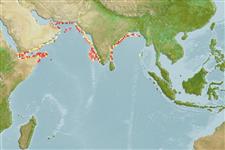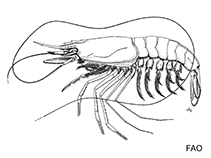Aristeus alcocki Ramadan, 1938
Arabian red shrimp| Native range | All suitable habitat | Point map | Year 2050 |

|
| This map was computer-generated and has not yet been reviewed. |
| Aristeus alcocki AquaMaps Data sources: GBIF OBIS |
Upload your photos
Google image | No image available for this species;
drawing shows typical species in Aristeidae.
Google image | No image available for this species;
drawing shows typical species in Aristeidae.
Classification / Names Common names | Synonyms | CoL | ITIS | WoRMS
Malacostraca | Decapoda | Aristeidae
Environment: milieu / climate zone / depth range / distribution range Ecology
Benthic; depth range 270 - 1086 m (Ref. 8). Tropical; 25°N - 9°N, 43°E - 92°E
Distribution Countries | FAO areas | Ecosystems | Occurrences | Introductions
Indian Ocean.
Length at first maturity / Size / Weight / Age
Maturity: Lm ? range ? - ? cm Max length : 15.0 cm TL male/unsexed; (Ref. 8); common length : 11.0 cm TL male/unsexed; (Ref. 8); common length :14 cm TL (female)
Life cycle and mating behavior Maturity | Reproduction | Spawning | Eggs | Fecundity | Larvae
Members of the order Decapoda are mostly gonochoric. Mating behavior: Precopulatory courtship ritual is common (through olfactory and tactile cues); usually indirect sperm transfer.
Main reference
References | Coordinator | Collaborators
Holthuis, L.B. 1980. (Ref. 8)
IUCN Red List Status (Ref. 130435)
CITES status (Ref. 108899)
Not Evaluated
CMS (Ref. 116361)
Not Evaluated
Threat to humans
Human uses
Fisheries: of potential interest
| FishSource |
Tools
More information
Internet sources
BHL | BOLD Systems | CISTI | DiscoverLife | FAO(Publication : search) | Fishipedia | GenBank (genome, nucleotide) | GloBI | Gomexsi | Google Books | Google Scholar | Google | PubMed | Tree of Life | Wikipedia (Go, Search) | Zoological Record
Estimates based on models
Preferred temperature
(Ref. 115969): 9.8 - 14.4, mean 11.4 (based on 9 cells).
Resilience
(Ref. 69278):
High, minimum population doubling time less than 15 months (K=0.41-1.2).



